Oxford: Magic, Myth and Martyrs
by Sue Kendrick
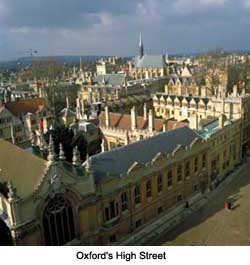 It's not just
Matthew Arnold's "sweet spires" that dream in Oxford.
As soon as you set foot in the town you find yourself slipping
into the same kind of altered consciousness that presumably
invoked his lyrical poem, Thyrsis. It's not just
Matthew Arnold's "sweet spires" that dream in Oxford.
As soon as you set foot in the town you find yourself slipping
into the same kind of altered consciousness that presumably
invoked his lyrical poem, Thyrsis.
In spite of shoppers, students and a healthy influx of tourists,
there is a hint of surreal magic lurking in the air -- which may
account for the proliferation of fantasy writers that have found
inspiration amongst the myths, legends and bloody turbulence that
make up Oxford's kaleidoscopic past.
This colourful past begins with the legend of Frideswide, a Saxon
princess and nun who built a monastery at the "Ox" ford
crossing of the river Thames somewhere around 700 AD. The fact
that the town didn't take the name Frideswide suggests there was
a settlement of sorts already there, but you can't help feeling
that the princess missed out in the recognition stakes in more
ways than one.
Apart from establishing a very prosperous monastery on the site
now occupied by Christ Church College and Cathedral, Frideswide
also gained a reputation as a miracle worker when she very
charitably (you can't help but think) restored the sight of a
lecherous king who had been struck blind by a lightening bolt
when in hot pursuit of her maidenhood!
This seemingly miraculous cure was enough to establish the cult
of St Frideswide, with pilgrims flocking to pay homage at her
tomb and perhaps hoping to reap the benefit of her powers. The
monastery flourished along with the town that grew up around it
and quickly became a centre for educational excellence. This had
its price, however, and a town full of drunken, rowdy students
was as unwelcome then as now. Discontent between "town and
gown" finally came to a head in 1355 when a student threw a
pot of wine an innkeeper.
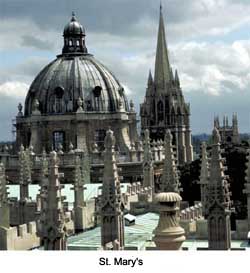 As is
usual in times of conflict, opposing parties were keen to have
their aggression sanctified by the Almighty. The antagonists
used two of the town's churches as mustering points. Citizens
rallied to the bell of St. Martin's while the university students
flocked to St. Mary's. Riots and running battles lasted for
three days, during which 63 students were killed and many more
injured. Once order had been restored, the mayor was imprisoned
and the university's power in the town increased. For the
following 500 years the mayor and corporation were forced to
parade to an annual St. Scholastica's Day service at St. Mary's
to do penance for their misdeeds. As is
usual in times of conflict, opposing parties were keen to have
their aggression sanctified by the Almighty. The antagonists
used two of the town's churches as mustering points. Citizens
rallied to the bell of St. Martin's while the university students
flocked to St. Mary's. Riots and running battles lasted for
three days, during which 63 students were killed and many more
injured. Once order had been restored, the mayor was imprisoned
and the university's power in the town increased. For the
following 500 years the mayor and corporation were forced to
parade to an annual St. Scholastica's Day service at St. Mary's
to do penance for their misdeeds.
Both St Martin's and St Mary's are still in existence, with the
tower of St. Martin's of particular interest. This dates from
the 14th century and bears a clock with ornate quarterboys in
Roman military dress. These are replicas; the originals are on
display in the Oxford museum, which not only details the growth
of the town from prehistoric times but gives some insights into
its economic growth, including Frank Cooper's marmalade factory.
St Mary The Virgin, situated in Radcliffe Square, was once the
centre for university life and housed the library and treasury.
It also hosted lectures and ceremonies and, more gruesomely, was
where Archbishop Cranmer received his death sentence in 1556.
Look carefully in the north aisle and you will see a groove in a
pillar made by the platform erected for this purpose.
If you can manage a 127-step climb to the church roof line, the
whole panoramic view of Oxford is revealed in all its
honey-stoned, gothic-spired splendour! From this lofty vantage
point, glimpses of most of the town's 39 colleges can be seen:
solid buildings of age-worn stone embracing neat quadrangles of
carefully tended lawns. Each has a tale to tell, most of which
can be heard by taking one of the regular, organised tours that
take place around the colleges throughout the year. If time is
short, though, make sure your trip includes the magnificent
Christ Church College and Cathedral, possibly the jewel in the
Oxford crown and certainly the centre of Oxford's ecclesiastical
beginnings.
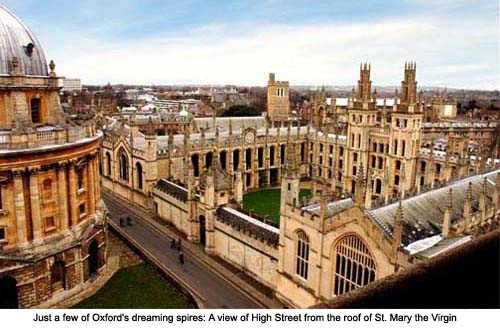
These glittering gems occupy the same site within the town
centre. Open every day of the year apart from Christmas day,
the Cathedral contains the shrine of St. Frideswide herself,
rebuilt and restored after Henry VIII's efforts to smash and
destroy it during the dissolution of the monasteries in 1538.
Another rarity in the Cathedral is the Becket window, which shows
the murder of Archbishop Thomas Becket. Henry VIII ordered all
depictions of this murder to be destroyed, but the Becket window
was preserved simply by blocking out the face.
The present building dates from the late 12th century, replacing
the previous priory church, which was deliberately destroyed by
fire. Little is made of the St Brice's day massacre, perhaps
with good reason, as this is an appalling case of ethnic
cleansing that few townships would be proud of.
In 1002, King Aethelred (the Unready) had a hard time stemming
the waves of Viking invaders that were looting and pillaging the
country and demanding higher and higher rates of Danegeld. In
desperation, he issued an edict allowing the lawful killing of
any Dane found in the country. This had little effect against
the heavily armed raiders, but devastating consequences amongst
the settlers, traders and crafts people living in towns such as
Oxford.
On 13 November, St. Brice's Day, the Oxford Danish community took
refuge in St. Frideswide, hoping that the sanctuary of the church
would protect them from the incensed townsfolk. It was a forlorn
hope. The building was razed to the ground with the loss of many
lives. The King of Denmark's sister, Gunnhild, and her family
were said to have been amongst those that perished.
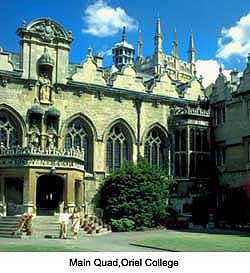 Christ Church College, which lies within the cathedral
grounds, was originally planned as Cardinal College by Thomas
Wolsey. The son of a humble butcher, Wolsey rose to become the
most powerful man in England, until he got in the way of Henry
VIII's plans to divorce the first of his six wives, Catherine of
Aragon. In typical fashion, Henry stripped Wolsey of his power
and refounded the college in 1546 as Christ Church College and
promoted the priory church of St. Frideswide to a cathedral,
making it the smallest cathedral in England. Christ Church College, which lies within the cathedral
grounds, was originally planned as Cardinal College by Thomas
Wolsey. The son of a humble butcher, Wolsey rose to become the
most powerful man in England, until he got in the way of Henry
VIII's plans to divorce the first of his six wives, Catherine of
Aragon. In typical fashion, Henry stripped Wolsey of his power
and refounded the college in 1546 as Christ Church College and
promoted the priory church of St. Frideswide to a cathedral,
making it the smallest cathedral in England.
A preoccupation with size is something that features quite
strongly in the design of Christ Church College. The Great
Quadrangle, or Tom Quad as it is affectionately known, takes its
name from the gatehouse tower built by Christopher Wren. A huge
bell by the name of Great Tom hung here and tolled once for each
scholar (101 times!) at 9.05 pm each day.
The quad itself is a wide and spacious area flanked by the
elegant symmetry of the university buildings. The combination
of spacious confinement certainly makes you feel insignificant
when strolling around the open-roofed cloisters. Not that this
cut much ice with Cromwell! During the Civil war, after he ousted
Charles I, he used the area to graze cattle and then went on to
slight the city in 1650 by removing its fortifications. He also
assumed the chancellorship of the University and replaced many of
the officials with his own favourites.
By contrast, the Peckwater Quad is small and enclosed, with the
buildings crowding and jostling around you. This was once the
site of a medieval Inn but now houses the Library as well as
student accommodation.
Charles Dodgson (better known as Lewis Carroll) was once one of
these students and these quads may well have been the inspiration
behind the "drink me" bottles encountered by Alice on
her trip to Wonderland in which she alternatively grew very tall
and then very small.
The fictional Alice actually had a real-life counterpart. She
was the middle daughter of Dean Liddell, who was in charge of the
cathedral. Dodgson befriended all the Liddel girls, but Alice
quickly became his favourite. His Wonderland and Looking Gass
stories were written for her, and he often used to take her to a
nearby shop in St Aldate's, which still exists and is to be found
opposite Christ Church College. Here Alice would buy barley
sugar, and the shop itself is featured in Through the Looking
Glass, where the fictional Alice is served by a bad tempered
sheep.
Unfortunately the shop these days is rather a disappointment.
You can still buy barley sugar and other sweeties, but the array
of tourist junk spoils the illusion somewhat.
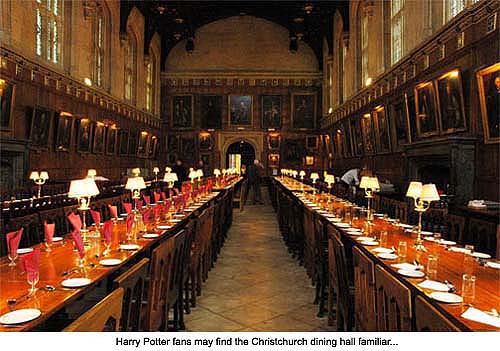
Fortunately illusion holds up well when you enter Christ Church
College Great Hall. This is everything you expect a medieval
banqueting hall to be: oak-panelled; huge fireplaces; rows of
blackened, scarred but highly polished dining tables set to feed
over 300 students each day. The hall also features a raised High
Table and walls festooned with paintings, including the college's
founder, Henry VIII, and some of the 13 prime ministers educated
at Christ Church.
Be warned! On entering the hall you may well experience a sense
of déjà vu. Fans of the Harry Potter films will
instantly recognise the Great Hall of Christ Church as the
setting for the dining scenes at Hogwarts School for Wizardry.
Other scenes were also shot at the college, which very neatly
continues the fantasy tradition begun by Dodgson towards the end
of the 19th century.
Fact, though, is often stranger than fiction and the Christ
Church College Dining Hall has seen its fair share of oddities.
During the English Civil War, Charles I held his parliament in
this vaulted building with the full support of the staunchly
royalist University. Elizabeth I enjoyed a play from the vantage
point of the raised table and Charlie Chaplain sampled a good
dinner from one of the many tables used to feed the students,
none of which have ever left the hall since their placement! (The
tables that is, not the students!)
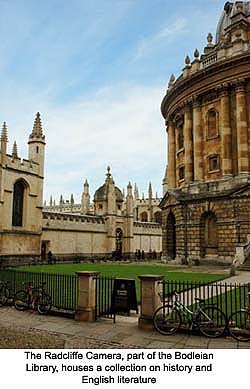 No
university town would be complete without a good library and the
one in Oxford is very special indeed. The Bodleian Library
houses literally millions of books due to the fact that its
founder, Sir Thomas Bodley, made an arrangement with the
Stationers' Company that a copy of every book published should be
given to the library. Unfortunately it's no good applying for a
borrower's ticket as none of the books can be removed from the
premises! In fact, in 1645 the library refused even King Charles
I the loan of a book! No
university town would be complete without a good library and the
one in Oxford is very special indeed. The Bodleian Library
houses literally millions of books due to the fact that its
founder, Sir Thomas Bodley, made an arrangement with the
Stationers' Company that a copy of every book published should be
given to the library. Unfortunately it's no good applying for a
borrower's ticket as none of the books can be removed from the
premises! In fact, in 1645 the library refused even King Charles
I the loan of a book!
The good news is that the Radcliffe Camera is now a private
reading room for the Bodleian library, adding to a total of
nearly 2,500 seats available for serious-minded scholars. This
very distinctive building was built in 1749 by James Gibbs' and
was originally intended as a library devoted to the sciences.
(The word "camera," by the way, does not refer to
photography, but means "chamber.")
Neither books or science proved much help to Archbishop Thomas
Cranmer and his fellow Bishops, Ridley and Latimer, when they
came to the notice of the Catholic Queen, Mary I. Concerned that
their Protestant influence could jeopardise the fragile
restoration of the Catholic faith, she had no qualms in throwing
them into Oxford's Bocardo prison, where they were cross-examined
at the Divinity school and tried for heresy.
Ridley and Latimer were burned at the stake in what was once the
town ditch but is now Broad Street. Worse was in store for the
unfortunate Cranmer. He was made to watch the grisly proceedings
from St Michael's tower, which proved enough to make him renounce
his faith. Not that it did him any good. Mary wasn't known as
"Bloody Mary" for nothing. On 21 March, 1556 he
followed his brother bishops to the stake and met a similar fiery
end. A cross in Broad Street marks the site of the burnings and
there is a memorial to the martyrs in St. Giles.
If Cranmer's experience of royal wrath reduced him to ashes, that
of the Empress Matilda very nearly ended in frostbite! Finding
herself besieged in Oxford's castle by King Stephen, she achieved
an ingenious escape by wrapping herself in a sheet and slipping
over the castle walls during a violent snow storm. This was just
one of many spats in the civil war between Matilda and Stephen
over who would wear the crown following the death of Matilda's
father, Henry I, in 1135. The Empress, not being very well
liked, soon found herself opposed by Stephen, Henry's nephew, who
claimed his uncle had appointed him heir on his deathbed. This
was just one of several of Matilda's close escapes during the
ensuing conflict.
Little now remains of the castle built in 1071 by Robert d'Oilly,
except its motte and a small stone keep. It's worth a look,
though, especially in wintry weather, as who knows what shrouded
figure you may see flitting through the gloaming!
 If
spectral figures and bleak winds are not to your taste, then the
Ashmolean Museum has plenty to interest. Its present collection
of art and antiquities is based on an early 17th century
collection by John Tradescant, who was a royal gardener. He
gathered most of the rarities in the collection when visiting
Europe to search for plants. The collection was inherited by
Elias Ashmole, who donated it to the University of Oxford in
1683. If
spectral figures and bleak winds are not to your taste, then the
Ashmolean Museum has plenty to interest. Its present collection
of art and antiquities is based on an early 17th century
collection by John Tradescant, who was a royal gardener. He
gathered most of the rarities in the collection when visiting
Europe to search for plants. The collection was inherited by
Elias Ashmole, who donated it to the University of Oxford in
1683.
One of its most prized possessions is the Alfred Jewel. This is
an incredibly beautiful artefact whose purpose is not entirely
clear. It bears the inscription "AELFRED MEC HEHT
GEWYRCAN," meaning "Alfred ordered me to be made."
It has been dated to the reign of Alfred, 871-899 and was
discovered four miles from Athelney, where Alfred had founded a
monastery. Made of gold, enamel and rock crystal, the purpose of
the jewel is not known. It could have been an "aestel,"
an object that Alfred sent to each bishopric when his translation
of Gregory's "Pastoral Care" was distributed. Each
aestel was worth 50 mancuses (gold coins), so was a very valuable
object. Aestels may have been used as book pointers. If so, there
should have been several such jewels, but so far no others are
known to exist. Others say that the jewel was a symbol of office,
either of Alfred or of one of his officials. The figure on the
Jewel is enigmatic; one theory has it as a representation of
Christ, while another is that the figure is the personification
of Sight.
Alfred was known as the greatest of Anglo-Saxon kings and through
his many endeavours against the Vikings was the only English king
ever to be given the title "Great." One of his biggest
achievements was establishing a defensive strategy consisting of
a network of fortified towns. The aim was to guard critical
strategic points against the Danes and provide a place of refuge
for the people of the surrounding countryside. Oxford was one of
these places, which were known as burhs by the
Anglo-Saxons.
Much is known about Alfred's military exploits and a little
regarding his lack of culinary expertise (remember those burnt
cakes?). Few realise, though, that legend has attributed to him
the founding of Oxford University, something historians say is
not as unlikely as it seems. Alfred was a great lawgiver and
passionately interested in education. He founded a school at
Winchester and taught himself Latin at the age of 40.
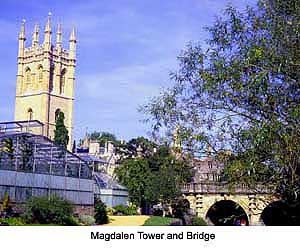 Mysterious jewels, nuns with miraculous powers,
queenly spectres -- no wonder Oxford has proved a fountain of
inspiration to the many writers and poets who have lived, worked
and studied here. In fact, the town hosted possibly the most
famous writers' group in the country: the Inklings. Its members
included C S Lewis, author of the Narnia books; J R R Tolkien of
Hobbit and Lord of the Rings fame; Charles William,
author of War in Heaven; Owen Barfield, author of The
Silver Trumpet; and many others of lesser fame. Mysterious jewels, nuns with miraculous powers,
queenly spectres -- no wonder Oxford has proved a fountain of
inspiration to the many writers and poets who have lived, worked
and studied here. In fact, the town hosted possibly the most
famous writers' group in the country: the Inklings. Its members
included C S Lewis, author of the Narnia books; J R R Tolkien of
Hobbit and Lord of the Rings fame; Charles William,
author of War in Heaven; Owen Barfield, author of The
Silver Trumpet; and many others of lesser fame.
The group usually met in Lewis' or Tolkien's rooms but meetings
were held in several of the town's pubs, most notably the Eagle
and Child (or more affectionately, the Bird and Babe). This is a
comfortable old pub on the Woodstock Road, serving good food with
a homey atmosphere. There is a display of Inklings memorabilia
in one of the rooms including photographs of members. Being very
partial to their beer and smokes, the Inklings also met in
several other pubs in the town, including the Lamb and Flag on
the other side of St. Giles; the White Horse on Broad Street
between Blackwell's and the Bodleian library; and the King's Arms
at the junction of Broad Street/Holywell Street and Parks Road --
which incidentally, serves excellent food. It's a good place to
end a day of dreaming amid the spires!
Related Articles:
- Oxford Timeline, by Darcy Lewis
- https://www.timetravel-britain.com/articles/towns/oxtime.shtml
- The Ashmolean Museum: Oxford's Window on the Ancient World, by Sean McLachlan
- https://www.timetravel-britain.com/articles/museums/ashmolean.shtml
- Oxford's Museum of the History of Science, by Sean McLachlan
- https://www.timetravel-britain.com/articles/museums/science.shtml
- The Hidden Churches of Oxfordshire, by Louise Simmons
- https://www.timetravel-britain.com/articles/churches/oxfordshire.shtml
- A Taste of Oxford: Sauce, Sausage and Hollyhog Pudding, by Dawn Copeman
- https://www.timetravel-britain.com/articles/taste/taste05.shtml
More Information:
We regret that we no longer have the resources to maintain up-to-date links and/or hours and pricing details for the various sites and attractions listed on this website. For more information about the location(s) listed above, please use your favorite search engine or visit Wikipedia.
Sue Kendrick is a freelance writer living in the English Midlands. She has written many special interest articles for magazines and newspapers and contributed an uncountable amount of news stories to her regional newspaper. She edits and publishes WriteLink (http://www.writelink.co.uk), a UK writers' resource website and monthly newsletter. She also writes fiction and has won several prizes for her short stories. When not writing, she likes to walk, ride, read and pursue her interest in small scale farming (not necessarily in that order!). For more information, visit http://www.suekendrick.co.uk.
Article and photos © 2006 Sue Kendrick
High Street from St. Mary's, Quadrangle, and Radcliffe Camera photos by Sue Kendrick; additional photos courtesy of Britainonview.com
| 